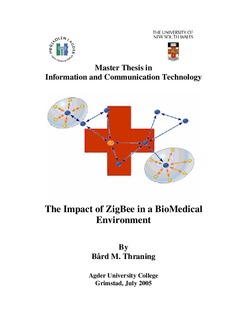| dc.contributor.author | Thraning, Bård M. | |
| dc.date.accessioned | 2007-06-28T12:40:31Z | |
| dc.date.issued | 2005 | |
| dc.identifier.uri | http://hdl.handle.net/11250/137174 | |
| dc.description | Masteroppgave i informasjons- og kommunikasjonsteknologi 2005 - Høgskolen i Agder, Grimstad | en |
| dc.description.abstract | The next generation of older people worldwide is predicted to reach 761 million by 2025, more than double what it was in 1990. During this century, for the very first time in human history the old will outnumber the young. The care demand for this generation will be enormous. Sensor networks have the potential to help reduce the workload of medical care. By introducing Body Area Networks of wireless vital sign sensors the collection of physiological data can be greatly simplified. The Body Area Network will be worn by patients who need 24 hours surveillance due to a chronic illness, and it will report any abnormalities to a physician. A good quality of life can be maintained for patients who can function in their everyday activities while being monitored.
The Body Area Network needs a wireless technology to transmit the vital signs data. Today many proprietary solutions have been developed, but the need for a globally standardized technology is absolutely present. This thesis investigates three IEEE standards and their upper specifications, and evaluates them up against a proprietary solution to see which will be the best fit for a Body Area Network. ZigBee, based on the IEEE 802.15.4 standard, is further explored to investigate its possibilities and weaknesses in a biomedical environment. Four scenarios are described to unveil its limitations. Those are later discussed and possible solutions are proposed.
In the evaluation of the wireless technologies ZigBee is found superior mainly because it is a standard, even though proprietary solutions can be better fitted to special uses. ZigBee being a global standard is a fact of cardinal importance in this case.
It is also found that ZigBee has what it takes to be the single technology in a complete monitoring scenario with multiple patients. It can perform adequately with its security properties, scalability, and power consumption, even though the relatively low data rate was anticipated to be an issue. Synchronization will still need some more work.
The impact of ZigBee would be that more companies could focus on increased product innovation since they do not need to develop proprietary solutions from scratch. | en |
| dc.format.extent | 1404586 bytes | |
| dc.format.mimetype | application/pdf | |
| dc.language.iso | eng | en |
| dc.publisher | Høgskolen i Agder | |
| dc.publisher | Agder University College | |
| dc.subject.classification | IKT590 | |
| dc.title | The impact of ZigBee in a biomedical environment | en |
| dc.type | Master thesis | en |
| dc.subject.nsi | VDP::Matematikk og naturvitenskap: 400::Informasjons- og kommunikasjonsvitenskap: 420::Kommunikasjon og distribuerte systemer: 423 | |
| dc.subject.nsi | VDP::Matematikk og naturvitenskap: 400::Informasjons- og kommunikasjonsvitenskap: 420::Systemutvikling og -arbeid: 426 | |
